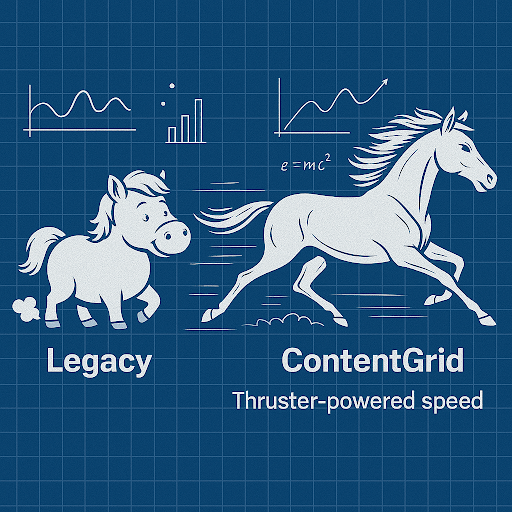ContentGrid V2: Limitless scaling with PostgreSQL 18
ContentGrid’s V2 release marks a new generation of content services. This is not an incremental update. It is a re-foundation. With a re-engineered architecture built close to the database layer (PostgreSQL), ContentGrid now delivers performance, scalability, and intelligence that set a new benchmark for the industry. The recent release of PostgreSQL 18 further accelerates the ContentGrid engine, with a 2–3x expected performance improvement from asynchronous reads.
Limitless scaling
Traditional content services have long been constrained by distance from the database. They often max out at a few hundred writes per second, while modern databases like PostgreSQL can handle thousands. ContentGrid V2 closes that gap. By aligning directly with the database engine, V2 operates at near-native database speed.
“To put that into perspective, typical legacy content services write 50, 100, or 300 documents per second, while PostgreSQL itself is capable of writing 3,000 to 5,000 objects per second or more,” says Ronny Timmermans.
This means scaling from millions to hundreds of millions of documents without friction.
Why does this matter? Because organizations face peak loads, growing archives, and rising expectations. Limitless scaling is not a luxury. It is the only way to ensure business continuity, customer satisfaction, and cost efficiency. V2 is designed to grow with you, maintaining performance even as your archive multiplies in size.


Architecture shift: closer to the core
One of the boldest changes in V2 is the replacement of Spring Data REST with jOOQ (Java Object Oriented Querying). By removing unnecessary abstraction layers, ContentGrid now operates almost one-to-one with PostgreSQL.
PostgreSQL is the strongest open-source database ecosystem in the world, constantly evolving with new extensions and features. ContentGrid V2 is engineered to ride that wave, delivering PostgreSQL-like performance as the technology advances.
With the arrival of PostgreSQL 18 and its asynchronous I/O, read operations become two to three times faster out of the box. Because v2 is architected so close to the core, these leaps in PostgreSQL immediately translate into leaps in ContentGrid. The result is compound acceleration: ContentGrid is faster on every version of PostgreSQL, and PostgreSQL itself keeps getting faster. Together, they drive exponential performance gains
A webinar is worth a thousand words
On November 6th, we hosted a live webinar unveiling ContentGrid V2, showcasing how this release redefines performance and scalability for modern content services. Our leadership team walked through the architectural breakthroughs behind V2. From PostgreSQL-level performance and limitless scaling to AI-powered intelligence and richer navigation, demonstrating what makes this release a true re-foundation of the platform.
Rich navigation
Finding and connecting content is as critical as storing it. With v2 we introduce bidirectional navigation, a breakthrough in how relationships between documents and entities are modeled. Bi-directional navigation is key to exploit the semantic model of contentgrid,.
In V1, relationships between entities were limited to a single direction. For example, a quote could link to an invoice, but the invoice could not point back. V2 changes that. Every relationship is automatically two-way.
Users can now move seamlessly from a quote to its resulting invoice and instantly back again, or navigate freely across any entity connections.
Rich navigation transforms discovery into a flexible, intuitive experience. Users can travel through business processes, exploring documents and their relations without artificial barriers. This delivers not only speed, but also a more natural way of working with content.
Performance beyond traditional ECMs
Legacy ECM systems struggle at scale. ContentGrid V2 delivers a 5 fold performance increase compared to traditional platforms. That is not just a technical gain. It is a business advantage.
Waiting three seconds for a page used to be acceptable. Today, if results are not instant, frustration sets in. Employees lose focus. Customers lose patience. Both start looking elsewhere.
Meanwhile, digital archives keep doubling. An insurer managing 250 million documents today could easily be at 500 million in ten years. Only a platform designed for the future can keep up. ContentGrid V2 ensures that as archives grow, responsiveness stays high.

Cloud economies
We have benchmarked ContentGrid against a real-world Legacy ECM. The increased performance we obtained is a result of lean architecture, and does not require increasing cloud resources and costs. While ContentGrid has a significant impact on required CPU, the savings become extreme in the amount of RAM, notably through the elimination of an external search service.
For RAM usage, the difference is spectacular. And still, with 100 M documents, ContentGrid and PostgreSQL keep all indexes in memory.
Smarter user experience
V2 also raises the bar for usability and quality. Better navigation, cleaner overviews, and more intuitive controls have been provided. Our UX team has re-engineered the front-end to introduce the TANSTACK framework, simplifying development. The front-end architecture is open sourced, and could benefit customers wanting to extend or replace the out of the box ContentGrid navigator interface.. These refinements create a smoother workflow for both architects and end-users.
Smarter experience. Higher quality. Built-in by design.
AI-driven search and classification
Manually adding metadata and setting relationships is a thing of the past. With ContentGrid v2, we enable users to use Artificial Intelligence to aid in document ingestion and classification. Although the intelligence of these models is remarkable, we still believe that the user should be in charge of the final decision. We view artificial intelligence as a tool to aid the user to find the correct solution, or information to his question/query.

A leap forward
ContentGrid V2 is built for speed, scale, and intelligence. By aligning with PostgreSQL 18 at the core, introducing rich bidirectional navigation, embedding AI for search and stability, and delivering unmatched cost efficiency, V2 redefines what a content services platform can be.
Our ambition is clear and simple: to be the fastest content services platform in the world. ContentGrid V2 is the step that brings us closer to that vision.

